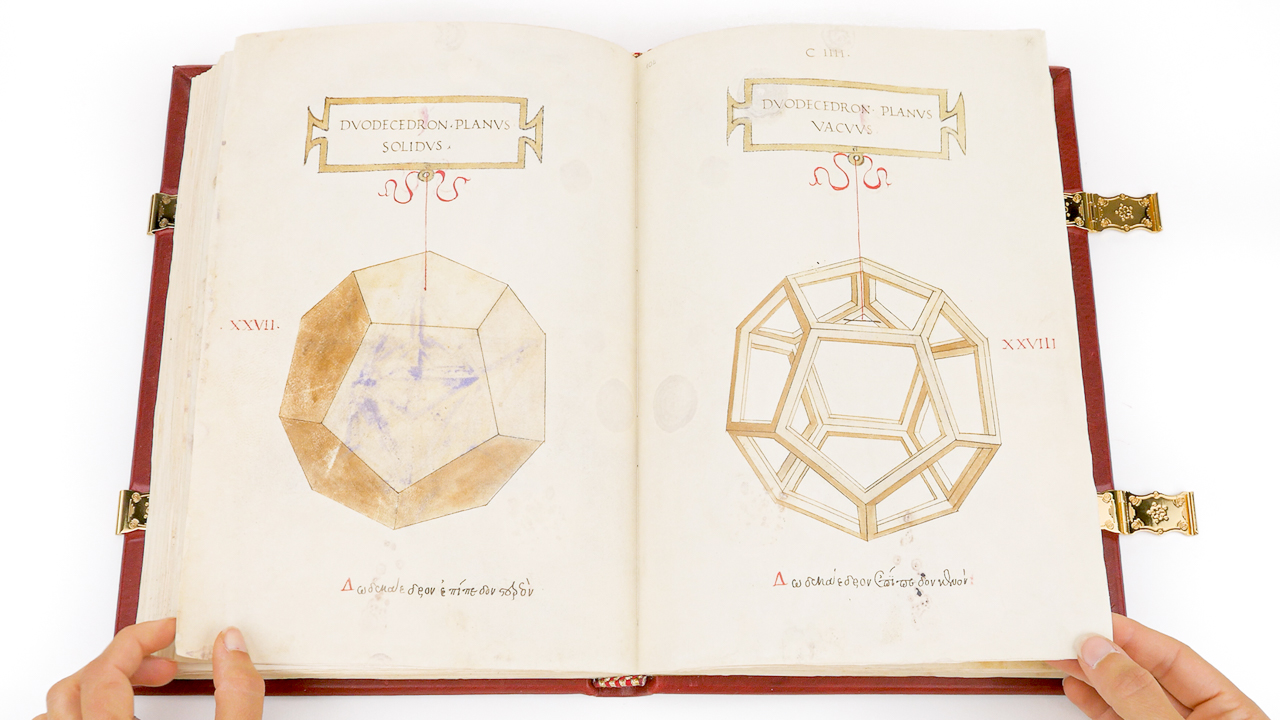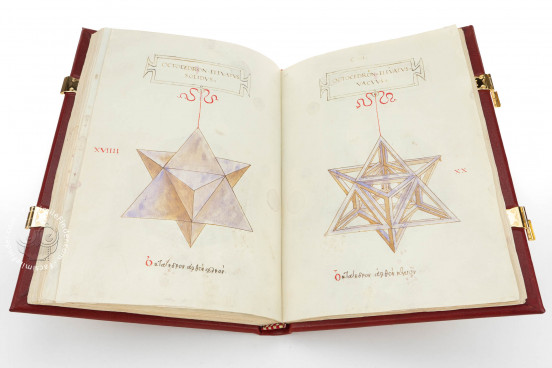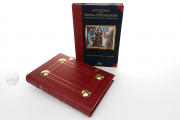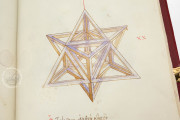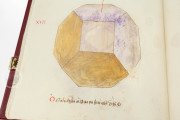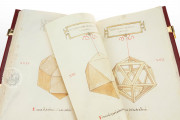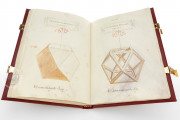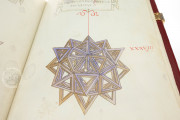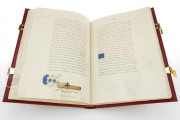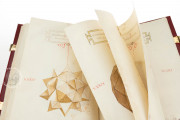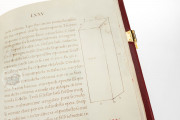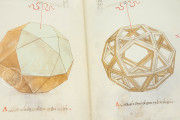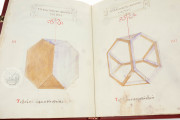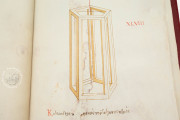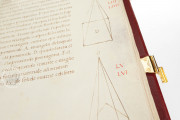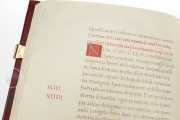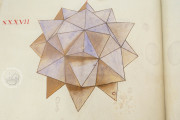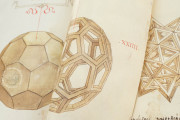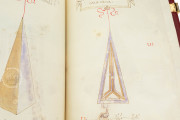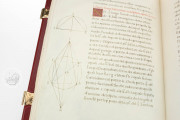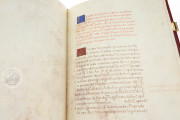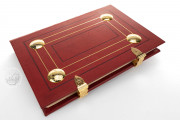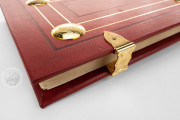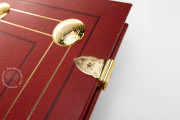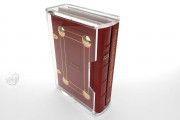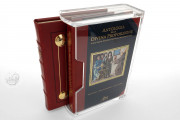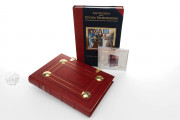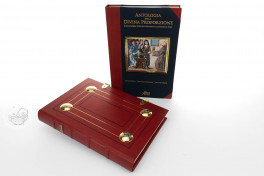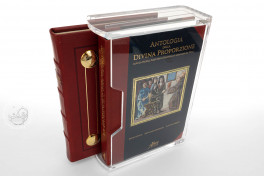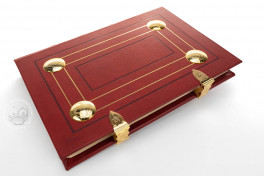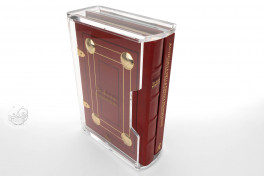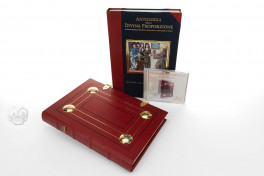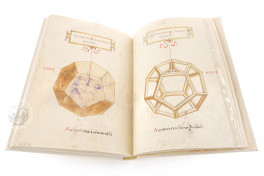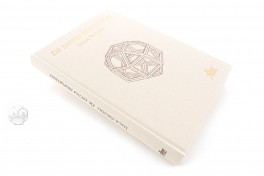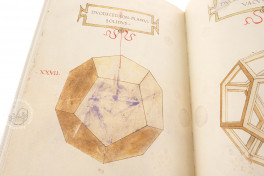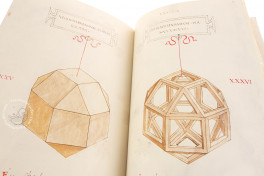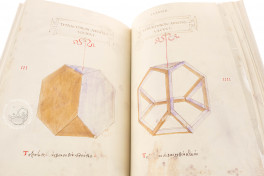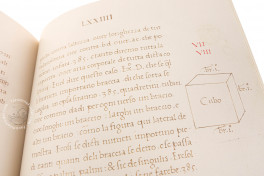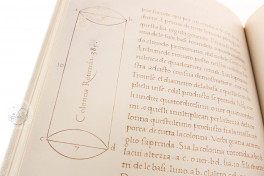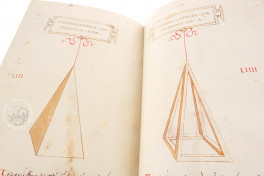Luca Pacioli (ca. 1445-1517) was arguably the greatest mathematician and geometer of his age. In his De Divina Proportione he brought together, for the first time in the vernacular, current thought on the divine nature of geometry. He also described the application of geometry to art and architecture imbuing these art forms with divine content. Working in Milan in close association with Leonardo da Vinci, Pacioli wrote a text that would have profound influence on science and art in the age of humanism. Leonardo himself drew the geometrical illustrations for the manuscript.
The Miniatures of De Divina Proportione
The important manuscript now preserved in Bibliothèque de l'Université de Genève was presented in 1498 to Ludovico Sforza, Duke of Milan. On the presentation page a miniature records the event. Ludovico Sforza, also known as Ludovico il Moro, is shown seated with four members of his court. He reaches out to accept the book proffered by its author. The Sforza arms decorate the lower section of the folio. For the De Divina Proportione, Leonardo da Vinci drew representations of 60 different polyhedrons. The crisp beauty of the geometrical, skeletonic figures is breathtaking. The drawings stand as a landmark in the evolution of stereography as they are the first to show clearly the distinction between the front and the back of the three-dimensional solids.
The artist: Luca Pacioli
Luca Pacioli was an itinerant, Franciscan teacher of mathematics. When working at the court in Urbino, he wrote a text in which he explained double-entry accounting. This text earned Pacioli a pre-eminent position in the history of commerce. He has been appropriately awarded the title "father of accounting" in the recent literature on business history. Fra Pacioli's fame led to an invitation to join the court of Ludovico Sforza in Milan where met Leonardo da Vinci. He taught Leonardo the intricacies of geometry and Leonardo informed Pacioli of the application of geometry to art and architecture.
The Divina Propotione
The text of De Divina Proportione clearly depended on the close collaboration of these two Renaissance scholars. In his study of Divine proportion Pacioli first dealt with current thinking on theology, philosophy and music in the light of mathematics as expressed in the golden ratio (golden section or golden mean). He turned to a study of Euclid's Elements and then to a consideration of regular and dependent polyhedrons.
The remainder of the manuscript includes a treatise on architecture, based on Vitruvius and a translation into Italian of Piero della Francesca's Short Book on the Five Regular Solids (Libellus de quinque corporibus regularibus). This translation allowed for wide dissemination of Piero's important contribution to writing on perspective and proportionality. Piero della Francesca and Pacioli had certainly exchanged ideas on geometry and art at the court in Urbino.
The foundamental importance of the masterpiece
The entire text of De Divina Proportione stands as a compendium of theological, theoretical and practical mathematical knowledge that would resonate in the world of Renaissance art and architecture.
In the case of Leonardo da Vinci geometrical analysis of his subsequent work clearly points to his thorough understanding and acceptance of Pacioli's ideas of the Divine in the golden ratio.
The importance of this manuscript in the life and works of Pacioli is clear in the three extant portraits of this often underappreciated humanist. The image in the presentation miniature was preceded by a portrait painted by his friend Piero della Francesca who cast Pacioli in about 1473 as St. Peter Martyr in The Montefeltro Altarpiece – a critical monument in the history of art. The significance of De Divina Proportione was celebrated in a portrait of its author by Jacopo de Barbari (Museo Capodimonte in Naples). Pacioli is shown standing behind a table on which are the instruments of geometry and a book, quite possibly his De Divina Proportione, in red leather binding. That this is a pictorial monument to his manuscript with its illustrations by Leonardo da Vinci, is suggested by pictorial representations of a transparent polyhedron (rhombicuboctahedron) suspended from the ceiling and an opaque dodecahedron sitting on top of the bound manuscript.
We have 2 facsimiles of the manuscript "Geneva Compendium on Divine Proportion":
- De Divina Proportione (Special Collections Edition) facsimile edition published by Aboca Museum, 2009
- De Divina Proportione (Circulating Stacks Edition) facsimile edition published by Aboca Museum, 2009

